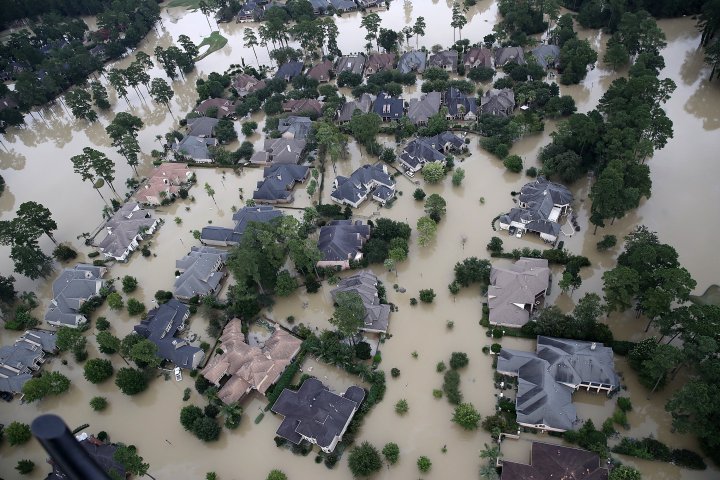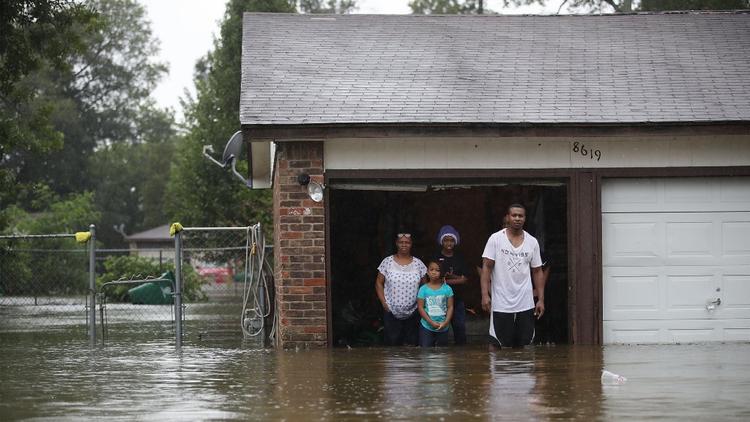Race, Necropower, and Natural Disasters

In the last month, Hurricanes Harvey and Irma devastated Texas and Florida, killing scores of people and leaving many more homeless. Residents in the Miami area also faced a mandatory evacuation order, although many were unable to escape the storms. Those who lacked the resources to leave were disproportionately Black. They faced deadly flooding and days without power, which can itself be deadly in South Florida’s late summer heat. And then there are those in jails and prisons, for whom evacuation is not a matter of choice. Conditions in such facilities deteriorated rapidly after the storm, with incarcerated people trapped in cells with standing water, and urinating and defecating in plastic bags. If the people in these facilities look at all like prison populations nationwide, they are disproportionately Black as well.
In the wake of Hurricane Harvey, news outlets insisted that the storm “didn’t discriminate.” Historian of disaster Jacob Remes pushed back against this view of a dispassionate Mother Nature, pointing out that “even though the wind and rain draw no distinctions of race, class, or immigration status, the disasters they create often replicate and deepen social inequalities.” But these storms don’t merely amplify aberrant parts of American society; rather, they expose the racial violence at its core.
Political theory can help us to connect what we saw on the ground in Texas and Florida, and to understand those events in the context of the American carceral state. Here Achille Mbembe’s idea of necropower provides a useful lens for viewing how the nature of state power and the power of nature intersect. Mbembe offers necropower—the “subjugation of life to the power of death”—as an elaboration on Michel Foucault’s theory of biopower, or the ways that governments regulate and manage the bodies of their citizens en masse. According to Mbembe, Foucauldian biopower cannot accommodate key features of contemporary politics and warfare, particularly “the creation of death-worlds, new and unique forms of social existence in which vast populations are subjected to conditions of life conferring upon them the status of living dead.” This is not necessarily new as a feature of American society. Orlando Patterson described slavery, on which the United States was built, as an institution of “social death.” However, looking at these storms in the context of Mbembe’s theory both draws out the illiberal features of contemporary American society and highlights the possibility for climate change to exacerbate them.
Mbembe finds necropower particularly at work in the colony and the apartheid state. Here “biopower, the state of exception, and the state of siege,” linked together by race, are fundamental to the exercise of power, which manifests as “the capacity to define who matters and who does not, who is disposable and who is not.” I’ll take each element of Mbembe’s description in turn.
In advance of Hurricane Irma, local law enforcement made clear that Black lives are indeed disposable. Grady Judd, the sheriff of Polk County in central Florida tweeted that officials would arrest and incarcerate anyone with an outstanding warrant who showed up at a shelter. This move was sure to discourage those with warrants and their loved ones from seeking safety amid a potentially deadly storm. Given the heavy policing of Black communities, African Americans would certainly be disproportionately represented among Polk County residents with outstanding warrants. Activist DiDi Delgado reads this as a thinly veiled attempt to dissuade Black Floridians from using public shelters at all.

Relief and recovery efforts are failing Black Floridians as well. In Miami’s historically Black neighborhoods like Overtown, residents are cash-strapped and struggling to find food, leaving residents to feel as though they have been forgotten in Irma’s aftermath. It would not be the first time—Miami’s Black residents were almost entirely excluded from recovery efforts following Hurricane Andrew.1 This is no accident. Overtown, once a vibrant center of Black culture and enterprise in the Magic City, was all but destroyed by urban renewal and the construction of Interstate 95. That devastation, which resulted from the conscious choice of mid-century urban planners, made Black residents more vulnerable to disaster by destroying Black wealth and disrupting community life. Today, the privileged and powerful can literally overlook Overtown residents from the freeway that runs above the neighborhood. This is remarkably similar to what Mbembe calls “vertical sovereignty,” in which colonial occupation “operates through schemes of over- and underpasses, a separation of the airspace from the ground.” Black disposability is thus built into the city’s infrastructure.
The second piece of Mbembe’s description is the state of exception, or the ability to declare oneself outside the rule of law as the defining feature of sovereignty. Police killings of African Americans suggest that law enforcement already occupies a state of exception with respect to Black life. The experience of federal prisoners during Harvey and Irma underscores this reality.
Thousands of incarcerated people at federal facilities in Beaumont, Texas were left in place to ensure the wrath of Hurricane Harvey and the squalid conditions that followed. The day before Irma struck South Florida, over four thousand incarcerated people within Miami-Dade Country’s evacuation area had not yet been moved. In an editorial for CNN, Van Jones and Jessica Jackson Sloan argued that this constituted cruel and unusual punishment. As evidence, they pointed to local zoos’ robust evacuation plans, and appeals for the protection of abandoned and stray cats and dogs.
Their argument assumes that readers view people in prison as human beings, and believe that their lives are at least as valuable as those of animals. This ignores the extent to which many Americans view criminal life as expendable, precisely because of its association with Blackness. For example, Tyler Roysdon, a volunteer firefighter in Franklin Township, Ohio, was recently suspended for commenting on Facebook that “one dog is more important than a million ni****s.” According to Mbembe, such is the nature of life in the colony or on the frontier, where the law of “civilized” society, including respect for human rights, breaks down. Here “savage life is just another form of animal life, a horrifying experience, something alien beyond imagination or comprehension.” The perceived sub-humanity of the colonized—here, African Americans—renders them disposable, and empowers the state to do the disposing.

The state of siege (or emergency) comes into play in two ways. On the one hand, natural disasters represent actual emergencies, in response to which governments may restrict the rights and movement of the citizenry, as with curfews implemented in Miami during and after Irma. Black residents who lack the means to evacuate will be disproportionately criminalized by such orders. Moreover, news coverage of storms and their aftermath create their own sense of emergency by focusing on looting, using frames that cultivate a sense of criminal emergency linked specifically to Blackness.
During both Harvey and Irma, news outlets also fed viewers a steady diet of reports and images of looting, such as those of Black residents carrying sneakers away from a Foot Locker in Fort Lauderdale. Such images reinforce viewers’ ideas about Black criminality, and fuel the sense of a permanent, racialized state of siege. Some who tweeted images of looting in Miami also called for the suspension of the rule of law after the hurricane. A user bearing the name “Another Deplorable” opined, “LOOTERS SHOULD ALL BE SHOT ON SITE [sic], NO QUESTIONS ASKED.” Hence, natural disasters create their own states of emergency.
Images of looting during and after the storms help to secure mass consent for heavy policing of Black communities, as well as the militarization of local police forces. These communities, who are the most affected by natural disasters, already lack the political capital and financial resources to make their neighborhoods more climate resilient. In addition, the harsh sentences that result from both racial policing and judicial bias are both materially devastating and rob poor people of a Constitutional tool that they do have to secure political change: the right to vote. Texas restores felons’ voting rights only once they have completed parole or probation, whereas Floridians with a felony conviction must individually apply for have their voting rights restored upon release.
In this way, natural disasters like Harvey and Irma both reveal the ways that Black life is already subjected to violence in American society, and render it still more vulnerable. But it is also worth noting that storms like these represent the “new normal” of a warming planet and rising seas, which is sure to bring social and political dislocation. Incarceration has been proffered—indirectly or otherwise—as a solution to problems ranging from mental illness to drug use to poverty, so what happens when the most incarcerated country in the history of the world faces an apocalyptic wave of deadly storms, earthquakes, and wildfires? What will this mean for our collective political future? Along with “disaster capitalism,” we will likely face the growing problem of disaster carcerality as well.
- David McBride, “Disasters, Public Policy, and Urban Black Communities: Urban Planning and Recovery during Hurricanes Andrew and Katrina,” National Political Science Review 17, no. 1 (2015): 37–55. ↩
